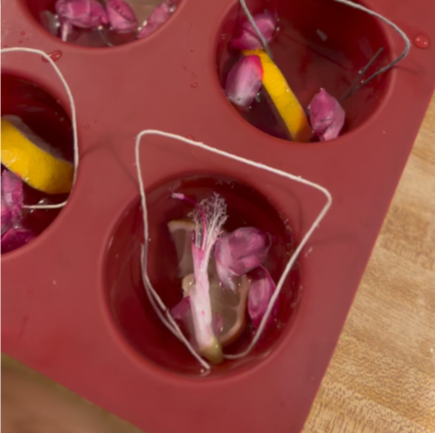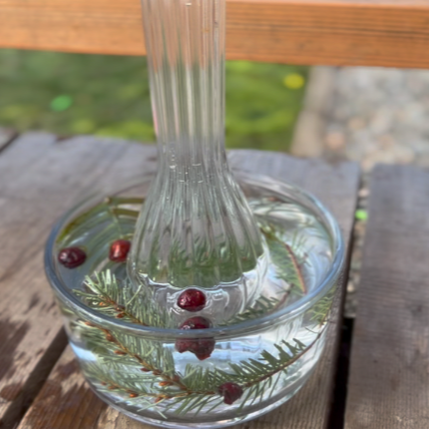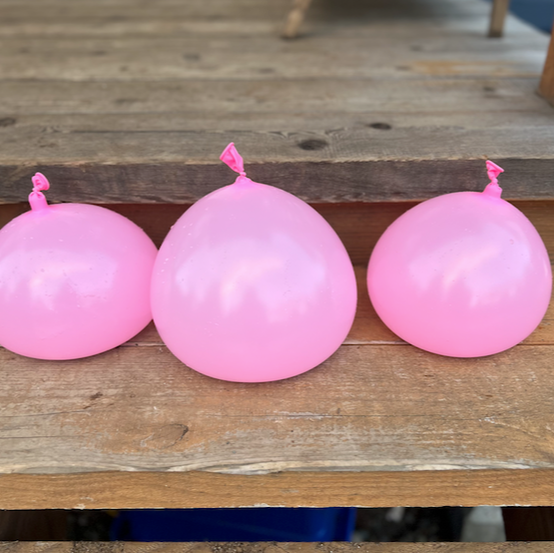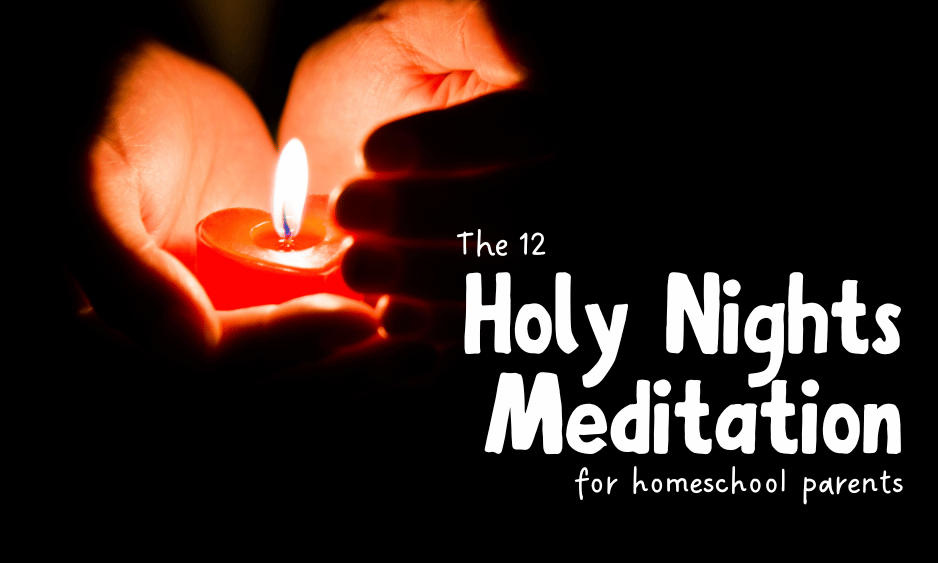|
For the most part, the temperature where we live stays above freezing. But occasionally, it dips below. And when this happens, making ice crafts helps us gain an appreciation for cold weather. Ice OrnamentsThere's no right or wrong way to make these ice ornaments. We used a muffin tray, but you could use any size container. We've used large bowls, ice cream buckets and tin pie plates. Place flower petals, sliced fruits, cranberries, ferns, sprigs of pine - really anything you like, into your chosen container. Fill with water and lay some twine or yarn in to become the handle. Place them outside overnight, and in the morning, pop your ornaments out and hang them around your yard. Ice CandleJust like the ornaments, you can make these in whatever container you have. We used an oven-safe thick glass bowl and a glass vase. We placed the glass vase into the centre of the bowl (to make the space for the candle) and filled it with water to weigh it down. Then we placed sprigs of pine, a fern and cranberries in the bowl and filled the bowl with water. We placed it outside overnight. We had to run some warm water over everything the following day, and then the candle holder popped right out. Ice GlobesFor these, we filled balloons up with water and let them freeze overnight outside. In the morning, we cut the balloon off, drilled a hole in the bottom and added battery-operated lights. Honestly, these are the most beautiful things to light a path with, and they bring so much light and joy to the frozen world outside. Flowers and blossoms are right around the corner, but ice ornaments, candle holders and globes are a lovely way to spruce up the bare trees and bring colour back to your yard until Spring arrives!
0 Comments
What are the Holy Nights?Anthroposophist, mystic, and teacher, Claudia McLaren Lainson explains the Holy Nights:
"In the darkness of Winter’s night, when the great breath of the Earth Mother finds its greatest point of inhalation, human beings are afforded the grace to touch into both magic and miracle. In the pause between her mighty in-breath and out-breath there is a still-point of rest. This still-point has long been known as the Holy Nights. In these blessed Nights, the angels circle the globe as if in a great cosmic dance. They long to speak to listening human hearts. Throughout the ages the ‘listening ones’ on earth have heard the angelic choir; they have received messages of Peace and Love. What is received during these sacred days and nights, resounds a thousand-fold in the year that follows. In this year before us, a great light is striving to find willing human hearts. May we each be the ‘listening ones’ during these Holy Nights. May we work with angels." Create Your Own Star LanternsThese geometric star lanterns are perfect for lantern walks and celebrating the Festival of Compassion. They are a little tricky, so may be better suited for older children, grade 4 and up. Materials
Step 1
Start by painting an 11″x14″ wet-on-wet watercolour painting with a basic colour wash or use a previously painted watercolour painting. Fall Songs for Young ChildrenSeasonal songs serve as a musical reflection of the ever-shifting environment, celebrating the beauty and significance of each season and a deeper appreciation for the cyclical nature of life. This approach fosters a sense of connection to the natural world and helps children develop a heightened awareness of time's passage, instilling a sense of harmony and balance with the world around them.
The following are some fun fall songs to incorporate into your daily rhythm this season. Daily Wonder refers to step-by-step guided lesson plans, but what do we actually mean by this?
Our step-by-step morning lesson unfolds in a typical Waldorf-style main lesson format. Each step that makes up the morning lesson is vital to your child's learning, and together, they create a meaningful experience. We thought it was time to share the wisdom behind these steps because when you know WHY you bring something to your child, you don't have to explain it to them. Instead, trust that you impart your understanding to them through feeling. Daily Wonder's step-by-step guidance flows like an artistic experience. In this way, your child is carried from step to step by your familiarity and deep understanding of each component. What are Nature Tables?What is a Nature Table and why do you see them in most Waldorf classrooms and in the homes of families who value Waldorf education? What purpose do they serve and why should you create one?
The most important way that history is shared is through story. Just think of the thousands and thousands of years of our history, where people shared stories around the fire, passed down from generation to generation.
When You're the Parent and Teacher of Multiple ChildrenA common question we get is, "how can I possibly homeschool successfully with more than one child?!!!
We at Daily Wonder fully recognize this challenge and are here to encourage you to go for it. We have collected our ideas based on teaching experience and feedback from other DW members. We hope you'll be inspired and encouraged to persevere through the inevitable learning curve. Let us remind you that not only do you need to learn to homeschool for two different grades, but most of you are new to homeschooling entirely and ought to cut yourself some slack. You heard it here; take a deep breath; you've got this! Here are the top 10 suggestions for homeschooling more than one child: How Does Daily Wonder Approach History and Geography?
We get asked this important question often, as we are a Canadian-based company with members worldwide. So, how exactly do we approach subjects that are location specific? We Follow the Waldorf Developmental Approach Pssst! We now have Kindergarten curriculum which you can find HERE AND we have a mini-course: Learn to Teach Finger Knitting which you can find HERE. The essential elements of a Waldorf Kindergarten are not the specific activities (baking, painting, etc.) but should reflect the underlying philosophy of Waldorf-inspired kindergarten: It's play-based, non-academic, and nature-inspired.
The kindergarten-aged child (and even the 3-4-year-old) learn through imitation, open-ended creative play, movement, music, stories, artistic activities and purposeful work. Your role as the parent is to form the daily and weekly rhythm, create lots of opportunity to learn and play, and build your relationship with your child. |
BlogExplore schedules, rhythms & routines, songs, music, festivals, free play, meals, projects & more to support your homeschooling program.Categories
All
Archives
July 2024
|
You might be wondering... |
Visit us on Teachers Pay Teachers© COPYRIGHT 2020. ALL RIGHTS RESERVED
Serving your worldwide educational needs from Comox Valley, BC, Canada. |















 RSS Feed
RSS Feed